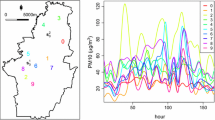Abstract
We develop a spatial statistical methodology to design national air pollution monitoring networks with good predictive capabilities while minimizing the cost of monitoring. The underlying complexity of atmospheric processes and the urgent need to give credible assessments of environmental risk create problems requiring new statistical methodologies to meet these challenges. In this work, we present a new method of ranking various subnetworks taking both the environmental cost and the statistical information into account. A Bayesian algorithm is introduced to obtain an optimal subnetwork using an entropy framework. The final network and accuracy of the spatial predictions is heavily dependent on the underlying model of spatial correlation. Usually the simplifying assumption of stationarity, in the sense that the spatial dependency structure does not change location, is made for spatial prediction. However, it is not uncommon to find spatial data that show strong signs of nonstationary behavior. We build upon an existing approach that creates a nonstationary covariance by a mixture of a family of stationary processes, and we propose a Bayesian method of estimating the associated parameters using the technique of Reversible Jump Markov Chain Monte Carlo. We apply these methods for spatial prediction and network design to ambient ozone data from a monitoring network in the eastern US.
Similar content being viewed by others
References
Abramowitz M and Stegun IA (1964). Handbook of mathematical functions. Dover, New York
Bras RL and Rodriquez-Iturbe I (1976). Network design for the estimation of areal mean of rainfall events. Water Resour Res 12: 1185–1195
Bernardo JM (1979). Expected information as expected utility. Ann Stat 7: 686–690
Brooks SP and Guidici P (2000). MCMC convergence assessment via two-way ANOVA. J Comput Graph Stat 9: 266–285
Caselton WF and Zidek JV (1984). Optimal monitoring network designs. Stat Probab Lett 2: 223–227
Cressie N, Gotway CA and Grondona MO (1990). Spatial prediction from networks. Chemometrics Intell Lab Sys 7: 251–272
Fuentes M (2001). A new high frequency kriging approach for nonstationary environmental processes. Envirometrics 12: 469–483
Fuentes M (2002). Modeling and prediction of nonstationary spatial processes. Stat Model 2: 281–298
Fuentes M, Smith R (2001) A new class of nonstationary models. Tech. report at North Carolina State University, Institute of Statistics Mimeo Series #2534
Gelfand AE and Smith AFM (1990). Sampling-based approaches to calculating margnal densities. J Am Stat Assoc 85: 398–409
Green PJ (1995). Reversible jump Markov Chain Monte Carlo computation and bayesian model determination. Biometrika 82: 711–732
Guttorp P, Le ND, Sampson PD and Zidek JV (1993). Using entropy in the redesign of an environmental monitoring network. In: Patil, GP and Rao, CR (eds) Multivariate environmental statistics, pp 173–202. North-Holland, Amsterdam
Ko CW, Lee J and Queyranane M (1995). An exact algrotihm for maximum entropy sampling. Operat Res 43: 684–691
Lindley DV (1956). On a measure of the information provided by an experiment. Ann Math Stat 27: 986–1005
Matérn B (1960) Spatial variation. Meddelanden fran Statens Skogsforskningsinstitut. (Almaenna Foerlaget, Stockholm. Second edition 91986), (vol 49, Issue 5). Springer-Verlag, Berlin
Müller P (1999). Simulated-based optimal design. Bayesian Stat 6: 459–474
Müller WG and Zimmerman DL (1999). Optimal designs for variogram estimation. Environmetrics 10: 23–27
Nychka D and Saltzman N (1998). Design of air quality networks. In: Nychka, D, Piegorsch, W and Cox, LH (eds) Case studies in environmental statistics, Lecture Notes in Statistics number 132, pp 51–76. Apringer Verlag, New York
Theil J and Fiebig DG (1984). Exploiting continuity: maximum entropy estimation of continuous distributions. Ballinger Publishing Company, Cambridge
U. S. Environmental Protection Agency (2003) National air quality and emissions trends report, 2003 special studies edition. U. S. Environmental Protection Agency, Office of Air Quality Planning and Standards, Research Triangle Park, NC 27711, EPA 454/R-03-005
Warrick AW and Myers DE (1987). Optimization of sampling locations for variogram calculations. Water Resour Res 23: 496–500
Wikle CK and Royle JA (1999). Space-time dynamic design of environmental monitoring networks. J Agric Biol Environ Stati 4: 489–507
Yfantis EA, Flatman GT and Behar JV (1987). Efficiency of kriging estimation for square, triangular, and hexagonal grids. Math Geol 19: 183–205
Zidek J, Sun W and Le N (2000). Designing and integrating composite networks for monitoring multivariate Gaussian pollution fields. Appl Stat 49: 63–79
Author information
Authors and Affiliations
Corresponding author
Rights and permissions
About this article
Cite this article
Fuentes, M., Chaudhuri, A. & Holland, D.M. Bayesian entropy for spatial sampling design of environmental data. Environ Ecol Stat 14, 323–340 (2007). https://doi.org/10.1007/s10651-007-0017-0
Received:
Revised:
Published:
Issue Date:
DOI: https://doi.org/10.1007/s10651-007-0017-0




